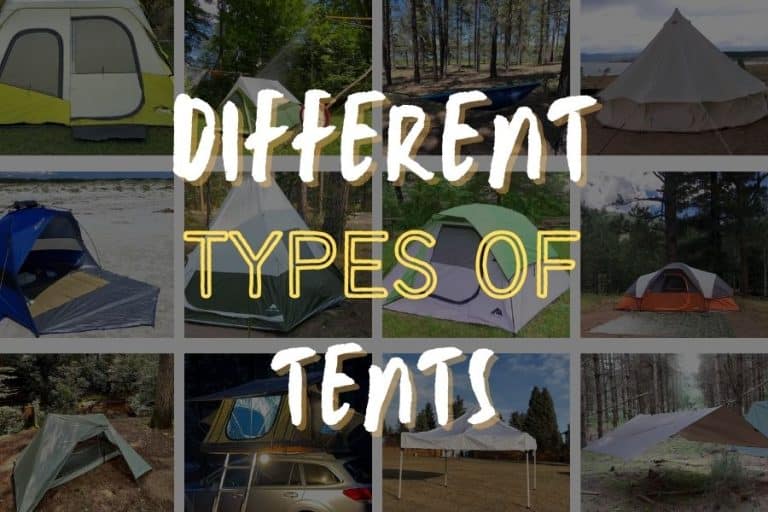In the search for a new tent, there are so many different types out there, it’s enough to make your head spin.
If you familiarize yourself with what each type of tent has to offer, you’ll be able to narrow down your search, which will make finding the perfect tent a lot easier.
And you’ve come to just the right place to do that.
In this article, we’ll go over all of the different types of tents available on the market, and give you a little bit of information about each one. You’ll find out where each type of tent shines, and what their weaknesses are.
Ready? Let’s get started!
Table of Contents
ToggleThe A to Z Of Different Types of Tents
Each type of tent is best suited to a specific purpose. A backpacker venturing out on a multi-day hike is going to need an entirely different tent to a family of 5 staying at a campsite.
Let’s take a look at some different types of tents and their main characteristics, so you can decide what’s going to work for you.
Common Tent Types
Family Tents
Backpacking Tents
Glamping & Luxury Tents
Winter Tents
Unique Tents
Quick-Pitch Tents
Day Use Tents
Common Tent Types
Dome Tents

Although it hasn’t always been the case, today the most popular type of tent would have to be the dome tent.
Dome tents typically have 2 poles that cross over (intersecting at the middle) to create a dome-like structure.
What do we think about dome tents here at Wilderness Times?
Well, what’s great about these tents is that they’re aerodynamic shape makes them fairly sturdy and stable in windy weather conditions.
This shape also allows water to fall straight down the sides of the tent, so you don’t have to worry about rainfall accumulating on the tent and weighing the roof down.
To top it all off, they’re generally easy to set up, and can be very lightweight and portable if made of synthetic materials.
On the downside, they don’t give you a lot of headroom to move around inside like cabin tents do. Their peak height is at the center of the tent, and it gets lower and lower as you move away from the center.
Our Recommendation: Kelty Grand Mesa 4 Tent
Cabin Tents
If a spacious tent is at the top of your list of priorities, you’d probably be best off going for a cabin style tent.
These tents are usually large in size, designed with big groups and families in mind.
But, what really makes all the difference when it comes to space is their straight (or near straight) wall structure.
What this means is that the peak height doesn’t drop as you move away from the center.
Rather, it remains constant throughout the interior of the tent. This means that you can walk around inside freely, as you would in your own home, without having to crouch over or crawl.
What’s the drawback?
I’m glad you asked.
Unfortunately, cabin tents don’t do very well when it comes to wind resistance. Their tall structure and vertical walls catch wind easily, and keeping one pinned down in a windstorm could prove quite challenging.
It’s also worth mentioning that because of their size, cabin tents tend to be on the heavier side of things. For that reason, they’re tailored towards car camping trips, rather than backpacking expeditions.
Our recommendation: Core Equipment 9-Person Instant Cabin Tent
A-Frame Tents
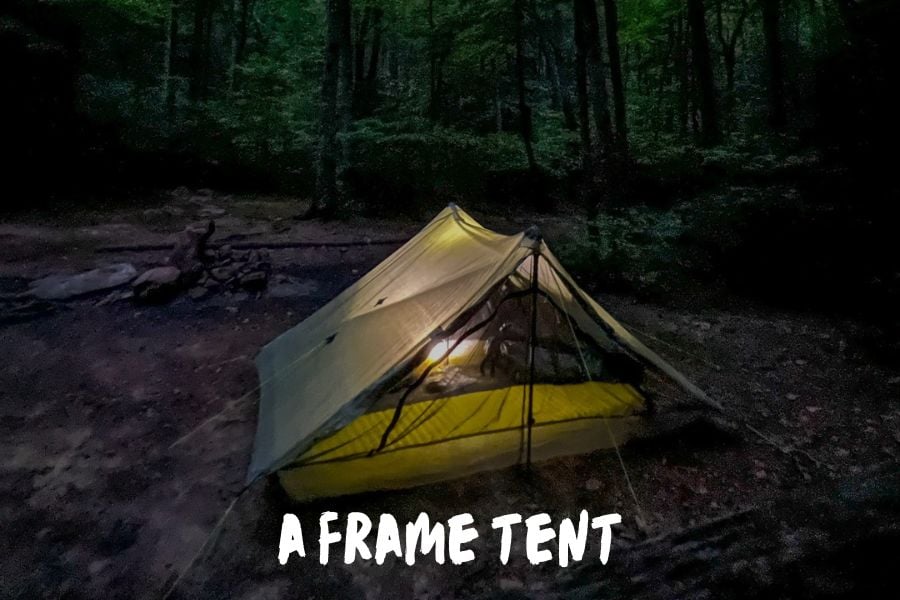
Once upon a time, A-frame tents were the most common sort you could find.
If I told you to draw me a tent, there’s a good chance you’d come up with a sketch of an A-frame tent.
As advancements in technology saw the introduction of fiberglass and aluminum tent poles, dome and cabin tents rose in popularity, leaving the A-frame tent behind.
That said, there are still some great A-frame tents being made today, and they come with their very own set of perks.
These tents are super simple to set up, light enough for backpackers, and their structure provides great wind and water resistance.
As the name suggests, these tents are in the shape of the letter A.
They’re held up by a pole at both ends in the middle, and staked down at the corners.
As is the case with dome tents, these tents don’t provide a lot of headroom either.
Then again, any tent that provides ample headroom is going to have a hard time standing up to strong winds, so it’s basically a tradeoff between headroom and wind protection.
Our recommendation: Naturehike Cotton Retro A-Frame Tent
Tunnel Tents
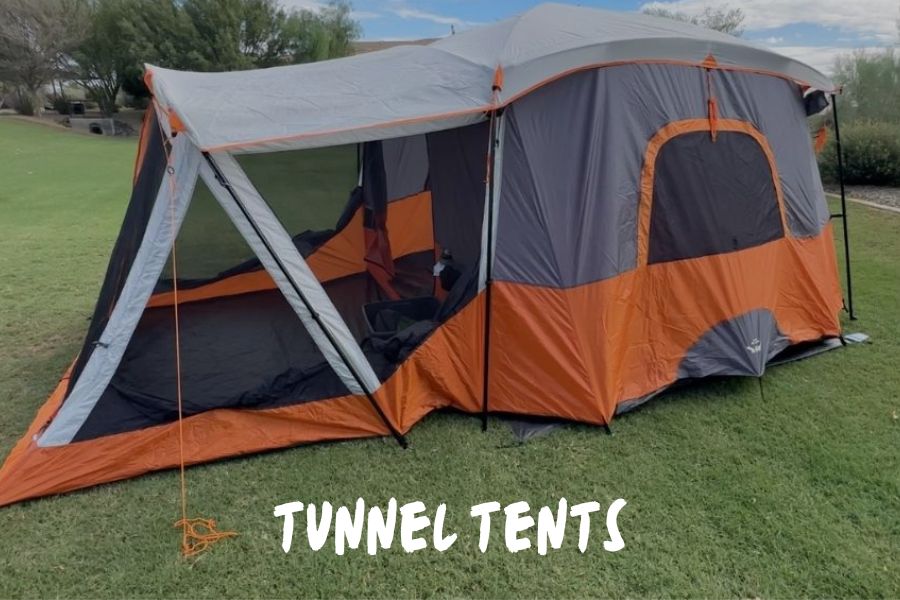
The poles on tunnel tents are arches, which stand parallel to one another, forming a tent in the shape of a tunnel.
A tunnel tent can have as little as 2 arches, but most have 3-4, while some larger models can have up to 5. Obviously, the more arches there are, the longer the tent will be.
The great thing about these tents is that they’re a piece of cake to set up, and they’re super spacious, providing a decent amount of headroom.
They also do fairly well when it comes to wind resistance. Just make sure to pitch it so that it’s facing in the same direction the wind is blowing, and your tent should have no trouble staying up.
The main problem you’re likely to have with a tunnel tent is water pooling on top of the tent between the poles. This can cause the tent to sag, and in extreme cases even collapse. For that reason, I wouldn’t recommend some tunnel tents for camping during the rainy season.
Our recommendation: REI Co-op Wonderland 6 Tent
Family Tents
Multi-Room Tents
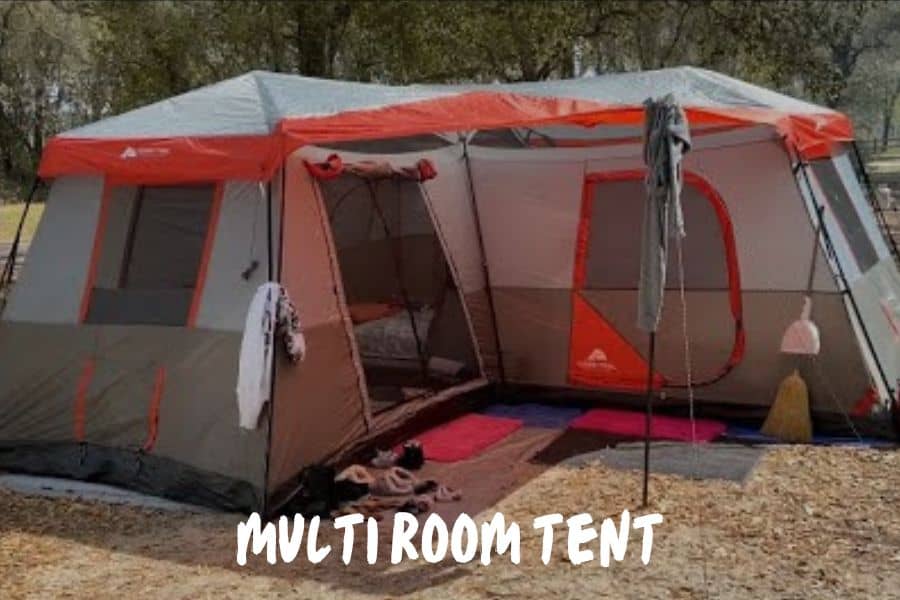
As tent-size gets bigger into the 8 person, 10 person, and even 12 person size, then we start to see what are called multi-room tents.
These tents are typically cabin or tunnel tents, and have fabric dividers that can be used to separate and give privacy.
Multi-room tents are perfect for big families with kids, or for large groups and multiple couples.
8 person tents will typically have one room divider to produce “two rooms” and larger 10-12 person tents may come with two dividers to make up to “three rooms”
Our recommendation: CORE 12 Person Instant Cabin Tent
Extended Dome Tents
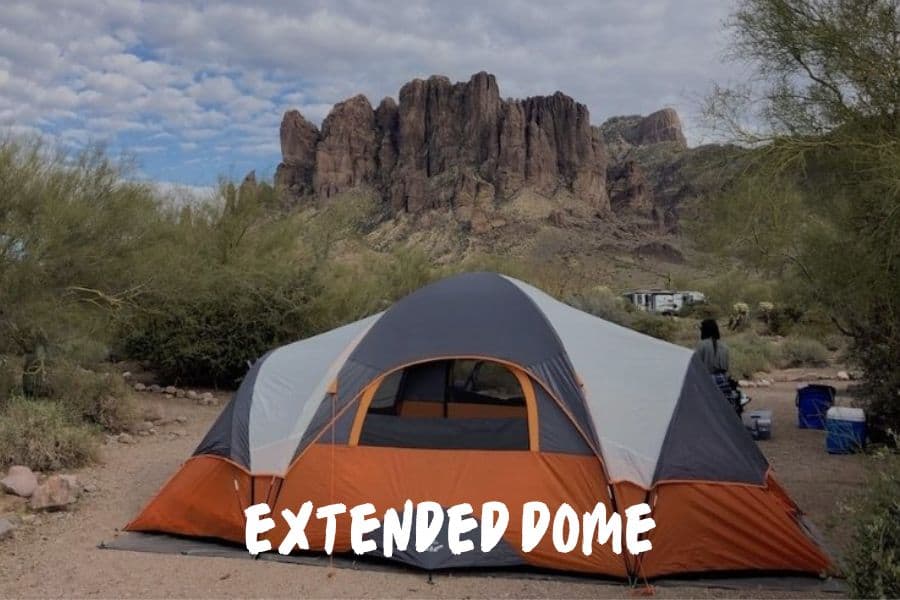
Another great tent for families are extended-dome tents.
Some of these tents may also be multi-room tents, but what we like about extended dome tents is that they can stand up to wind and rain better than their cabin-tent counterparts.
Extended dome tents will be large enough to sleep your entire family, plus have room inside of the tent for gear.
For this reason, extended domes are some of our favorite car camping and family tents around.
Our recommendation: Core 9 Person Extended Dome
Backpacking Tents
Backpacking Tents
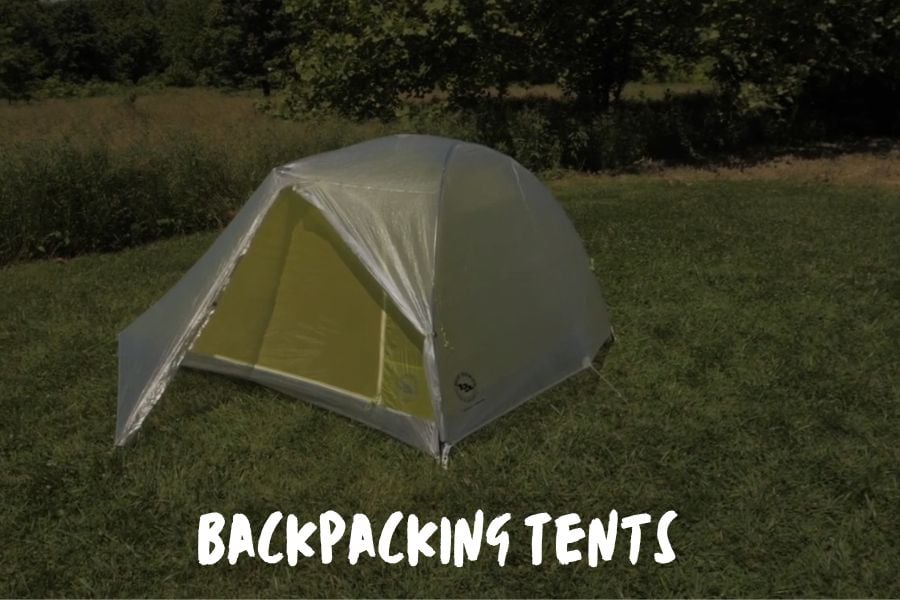
Backpackers need a tent that’s light enough to carry around on their backs for days on end. That’s where backpacking tents come in.
They come in 1 and 2 man versions, so you can fly solo or team up.
If you’re teaming up with someone, one of you can carry the poles, while the other carries the tent body, making it even easier to carry your tent around.
Aside from the fact that they’re super lightweight, they’re also super quick to set up and take down, so that you can easily move your campsite from place to place without any hassles.
These tents provide more space than bivy tents, while still providing excellent weather protection. They usually feature a vestibule or two, so that you can store your things outside the tent, while still shielding them from the elements.
Our recommendation: REI Co-op Half Dome SL 2+ Tent
Bivy Tents

If you’re a solo camper that enjoys backpacking and needs a light tent that they can carry around on their back easily, you might want to take a closer look at bivy style tents.
These tents are made for 1 person, and they weigh next to nothing.
On top of that, they’re about as good as it gets when it comes to weather protection. The fact that they’re so low means that the wind just flies right over them.
Even in seriously harsh weather, you’ll be safe and snug in a bivy tent.
Of course, it goes without saying that there isn’t a lot of space in one of these. Most of the time, you can’t even sit upright once you’re inside. These aren’t meant for hanging out in – their sole purpose is to give you a warm, secure place to sleep wherever you are.
Now, don’t go confusing a bivy tent with a bivy sack. Bivy sacks are great for staying warm, and in most cases you can sleep in one without a tent, but it still isn’t a tent.
A bivy tent will give you much more privacy than a bivy sack, and better protection from the elements. For wet weather especially, a tent is a much better idea.
Our recommendation: Snugpak Ionosphere Bivy Tent
Hammock Tents
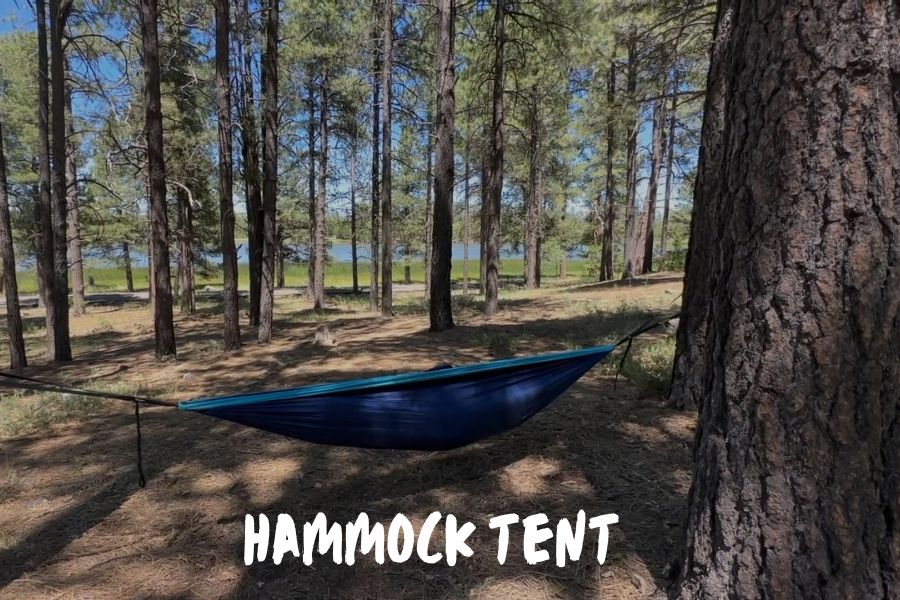
Hammock camping has really taken off in recent years, and it’s no wonder. Sleeping in a hammock, once you figure out the position, is one of the most comfortable ways there is to get a good night’s rest.
Not to mention the fact that you can hang them just about anywhere, regardless of what the ground is like underneath.
A hammock tent is a hammock that has fabric on top, as well as on the bottom. Sort of like a hanging cocoon.
Most of the time, the top is made of mesh for breathability and bug protection. The tent will then typically come with a rain fly that you can attach to stay dry in wet weather.
Another option is forgoing the rain fly and just hanging a tarp above your hammock. This is a good way to stay protected, while still getting plenty of fresh air circulating.
If you do go hammock camping, make sure you adhere to Leave No Trace principles and avoid harming the trees and your surroundings.
Our recommendation: Eno DoubleNest Hammock
Tarp Tents
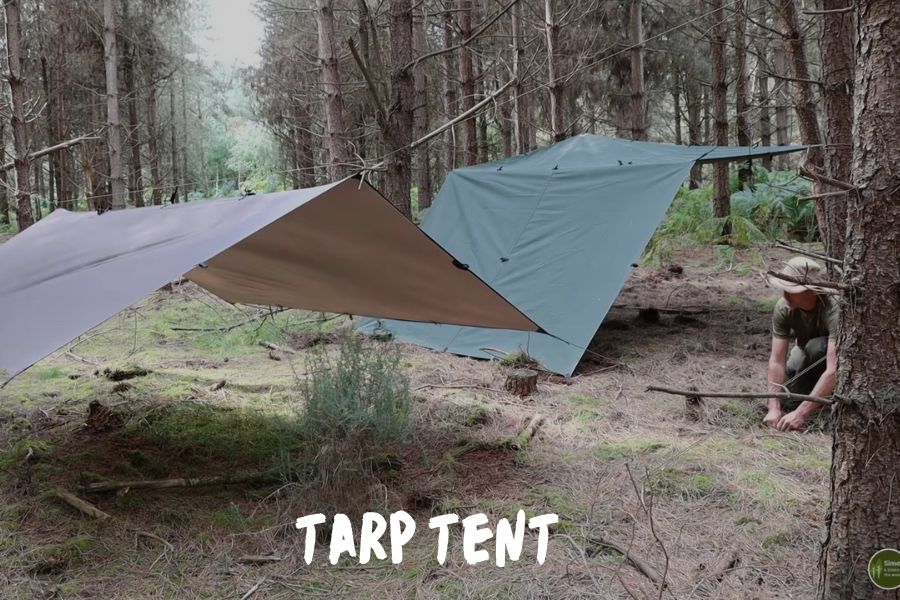
Tarp tents are so versatile, that it seems like there are endless combinations of tarp shelter configurations.
Our favorite is probably the lean-to, which is an easy and simple shelter to pitch in a bind.
The great part about tarp shelters, are that you don’t have to necessarily even plan on camping.
Bring your tarp with you on a day hike, and this way you are protected if the weather unexpectedly shifts on you.
You can also put a tarp over a tent, to provide added protection from the elements as well. One thing you will need to consider though when investing in a quality tarp, is you’ll also need to learn how to tie camping knots.
Our recommendation: ENO Eagles Nest Outfitters ProFly Rain Tarp
Winter Tents
Geodesic Tents
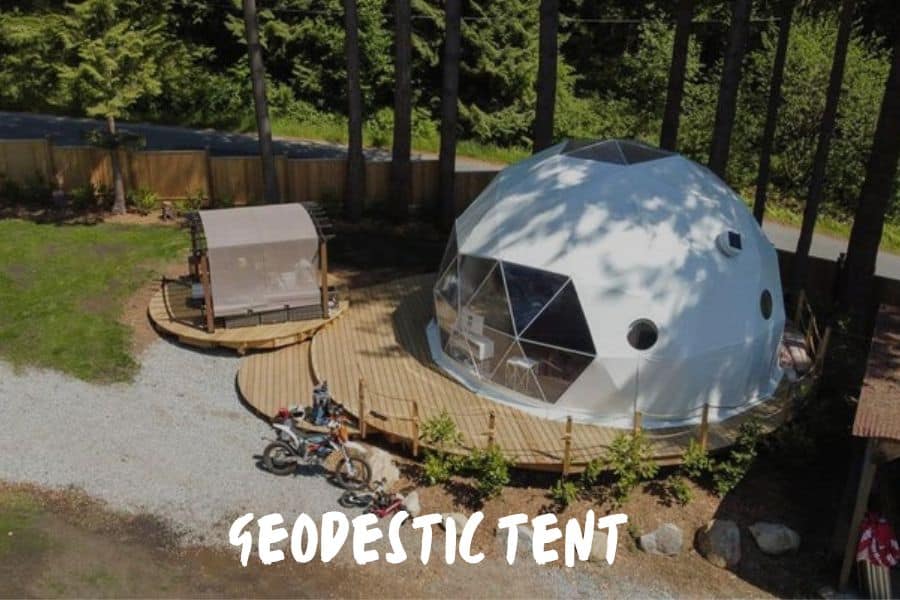
If a dome tent were a Pokémon, it would evolve into a geodesic tent.
These tents have a structure that resembles a dome, however, they have many more poles than a dome tent does.
These poles cross over at various points across the tent, creating supreme stability and weather resistance.
They tend to be lightweight, too, so carting one around with you wherever you go is no problem at all.
For backpackers and anybody camping in rough and unpredictable weather, a geodesic tent is an excellent option.
Beware, though, that they can be quite tricky to set up. The complex structure and multitude of poles is enough to make your head spin, so make sure you study the instructions carefully.
To minimize frustration on your camping trip, I strongly advise familiarizing yourself with the setup process by pitching the tent and taking it down a couple of times in your backyard or living room. That way, by the time you reach your campsite, you’ll know exactly what to do.
Our recommendation: ALPS Mountaineering Tasmanian 3-Person Tent
Hot Tents
xIf you’re looking for the ultimate winter tent, a tent you can live in year-round, and frankly, a badass tent, then hot tents are for you.
Hot tents allow you to house a tent stove within your tent. Tent stoves are perfect for keeping you warm on chilly nights and making your winter camping experience more enjoyable.
Best of all, there are many hot tents on the market today.
They come in various shapes and sizes, but the important key factor is they all come with a pre-cut stove jack coated with a fire-proof material that allows the tent stove piping to vent up and outside of your tent like a chimney.
Our Recommendation: the OneTigris Rock Fortress Hot Tent with Stove Jack
Teepee Tents
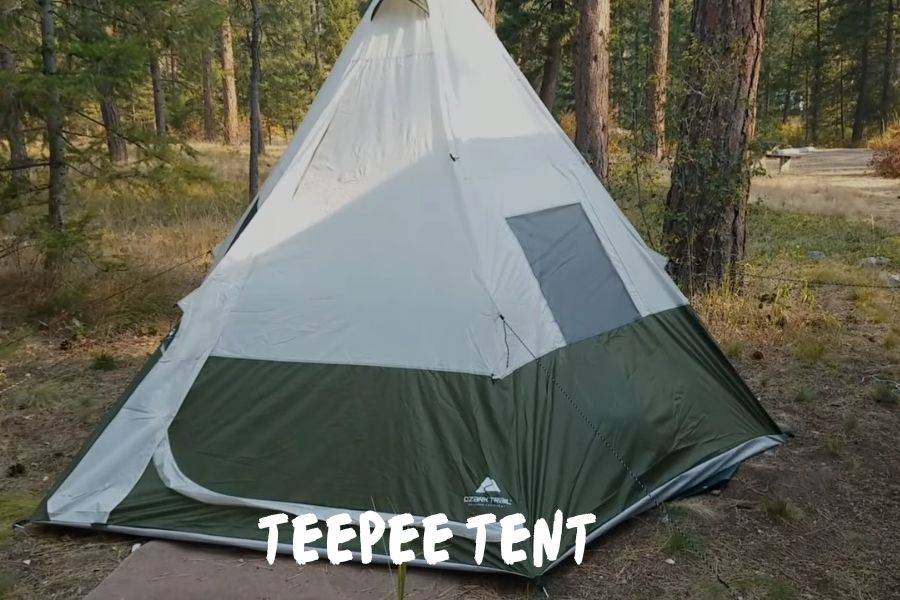
Speaking of teepee tents…
Of course, teepees were originally the traditional dwellings of Native American tribes. Today, you can find camping tents inspired by teepees, made of modern materials.
You might think they’re somewhat of a novelty, but teepee tents offer some unique benefits.
Their cone shape and tall center point provide an exceptionally spacious feel inside, and the roof vents allow hot air to rise and escape through the top of the tent.
The teepee tents used by indiginous tribes were constructed using animal skins. Today, they’re usually made of canvas, although there are also some synthetic options available for those who want a lighter, more affordable option.
Teepee tents usually feature a stove jack, so you can heat your tent with a wood burning stove to stay warm in cold weather.
Our recommendation: the Guide Gear Deluxe 18’ x 18’ Teepee Tent.
Glamping & Luxury Tents
Bell Tents
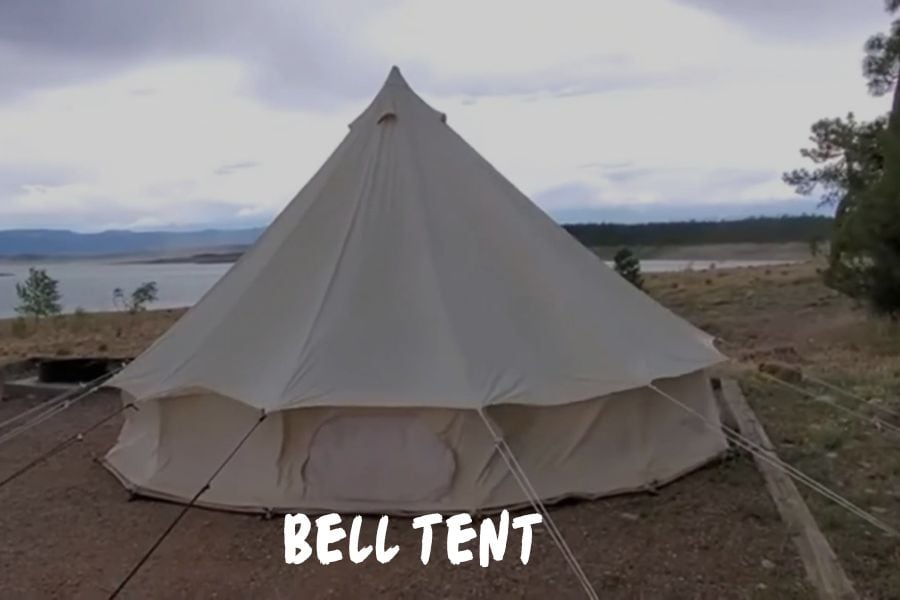
Although there are some exceptions, most of the time bell tents are made of canvas.
Canvas tents offer a vast range of benefits, such as breathability, durability, supreme weather protection and fantastic insulation.
That said, they’re also much, much heavier and more expensive than their synthetic counterparts.
For this reason, bell tents are often used for glamping.
Their structure is somewhat similar to that of a teepee tent. They have a pyramid shape and a center pole that holds the tent up.
However, instead of going straight down from the top of the center pole to the ground, the walls on a bell tent go straight up from the ground to a certain point. Then, from that point, they go up towards the top of the center pole.
It’s almost like the love child of the cabin tent and the teepee.
This structure gives you all the benefits of a teepee tent, with a lot more room to move around.
Our recommendation: White Duck 13′ Regatta Bell Tent
Canvas Tents
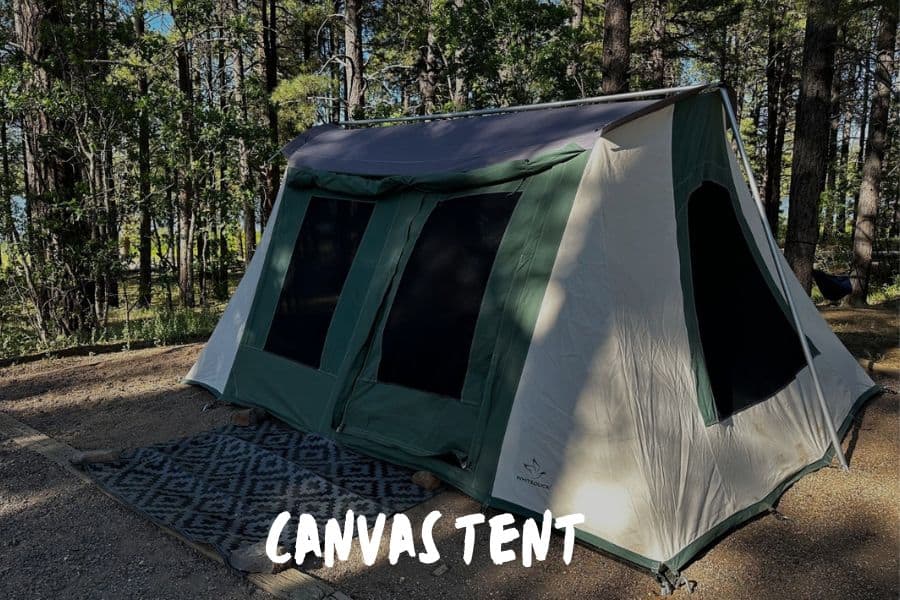
Canvas tents are an anomaly in the camping world.
Despite having a laundry list of advantages over standard polyester tents, canvas tents are nowhere near as popular.
Although they might cost more (in time and money), canvas tents have a lifespan that’s years (if not decades) longer than polyester tents.
If you buy a canvas tent now, it’s possible to last so long that you hand it to your grandkids!
Canvas tents have become the luxury go-to for glamping, because they can withstand the elements and make for a nicer, overall camping experience.
Our Recommendation: White Duck 10’X14′ Prota Deluxe Canvas Tent
Unique Tents
Suspended Tents
All I want for Christmas is… a suspended tent. Seriously. Someone please get me one. Anyone?
These things are insane. You tie them to trees, similarly to how you would tie a hammock – except for you need 3 trees instead of 2. Also, you tie it much tighter than a hammock.
What you end up with is a super comfy little sleeping area, floating up in the air.
This means you can set up camp in places where the terrain on the ground isn’t suitable for a tent. Just imagine all the awesome places you could sleep in one of these.
If you’re a fan of sleeping off the ground, but not into hammocks, you’ll go nuts for these tents.
I’m not gonna lie – it’ll probably take a few tries before you figure out how to set one of these up properly. It takes a bit of trial and error, but once you figure out the right angle, and how tight the straps need to be, you’ll be all good from there on in.
Truck Bed Tents
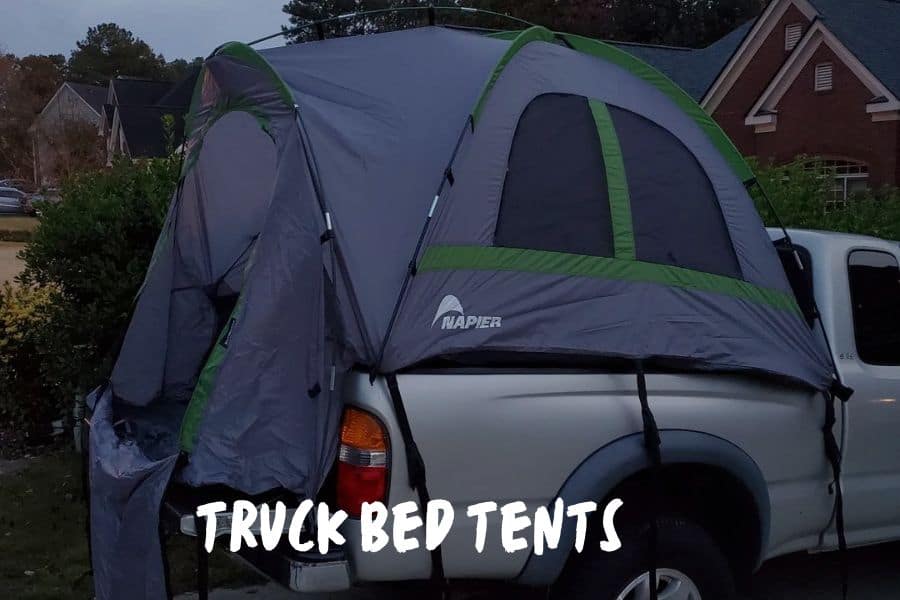
If you drive a pickup truck, you’d be crazy not to consider the prospect of getting a truck tent. These things are seriously cool!
They mount right on top of your truck bed, transforming it into a sleeping area. That means you can sleep in comfort and style wherever your truck is parked.
Whether it’s at a campsite, in the middle of the desert, or in a Walmart parking lot, all you need is a parking space and you’re good to go.
Some of them have a floor, while others don’t – this depends on your own personal preference. If, for instance, you have a tool box on your truck bed, you won’t be able to mount a tent with a floor over it.
Our recommendation: Napier SportZ Truck Tent.
Rooftop Tents
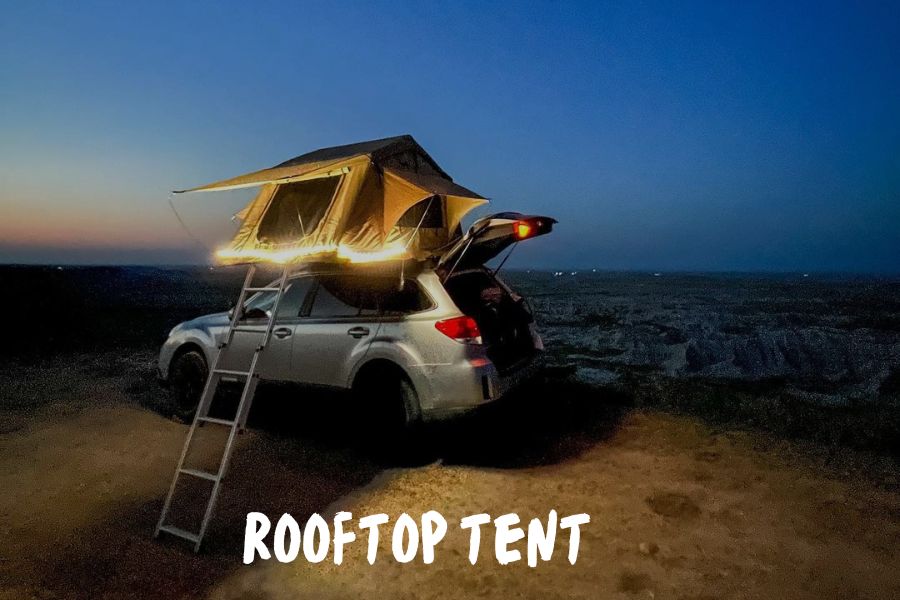
When it comes to SUV tents, you’ve got 2 different types to choose from:
- Rooftop tents
- Hatchback tents
Rooftop tents are set up on top of your SUV (duh) and they have a ladder that goes from the ground to the tent so you can get up and down.
The great thing about these is that you get to sleep high up off the ground, meaning you’re at a safe distance from snakes, bugs and any other critters that might come sniffing around in the middle of the night.
You also don’t have to worry about rising water levels flooding your tent if it’s raining.
One thing that might deter you from rooftop tents, however, is their weight. Most of them weigh over 150 lbs., which isn’t a small amount of weight to be carrying around on the roof of your car.
It also makes them quite difficult to get on and off the vehicle, and once it’s on there it’ll take quite a bit longer to set up than your average tent (unless you splurge for a Yakima SkyRise Rooftop Tent).
Our recommendation: The Yakima SkyRise Tent
SUV Tents
Hatchback tents set up on the ground, and attach to your SUV’s open trunk.
By joining the space in your trunk with the space inside the tent, you end up with a large, comfortable area with enough space for several people to sleep and store their gear.
You can choose to sleep in the trunk area, to be higher up off the ground. And, you can use the area on the ground for gear storage, or extra sleeping space if there’s more than 2 of you.
Our recommendation: Napier Outdoors – Sportz SUV Tent
Quick Pitch Tents
Instant Tents
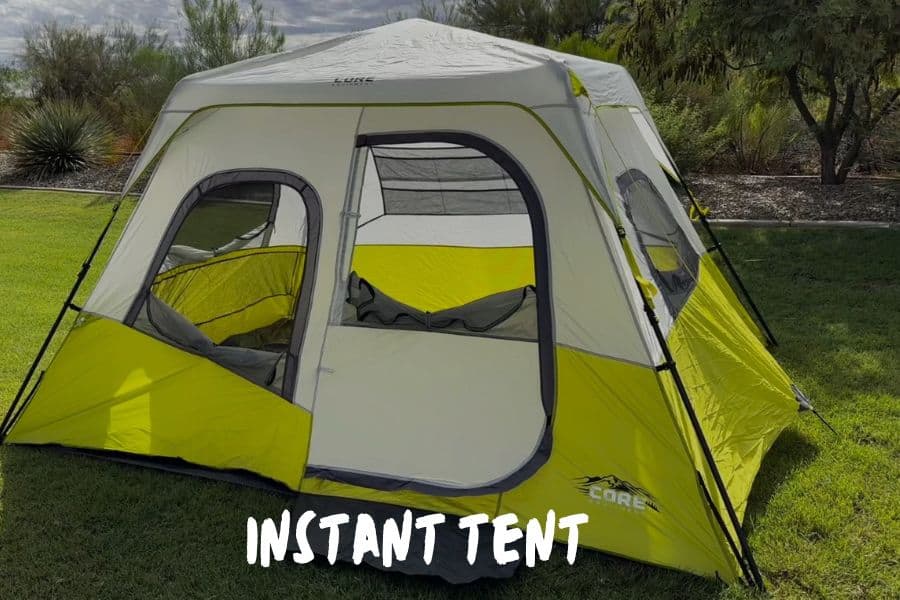
Here’s something for those that want a tent that can be set up in just a few minutes.
Instant tents are tents with pre attached poles, which means that the poles are already attached to the tent, so you don’t have to do it while setting up. All you have to do is unfold the tent, extend the poles and click them into place.
They come in a variety of different shapes including dome, cabin, A-frame, and even teepee.
If you’re not a fan of the setup process, hate fumbling around with poles and loops, and have always wished there was a quicker and easier way, an instant tent is a fantastic solution.
The catch is that they’re heavy and usually quite bulky when packed. That means that they’re off the table for backpackers, so they’re really only an option if you’re staying at a campsite, or somewhere else close to your car.
Our recommendation: Caddis Rapid 6 Tent
Pop-Up Tents
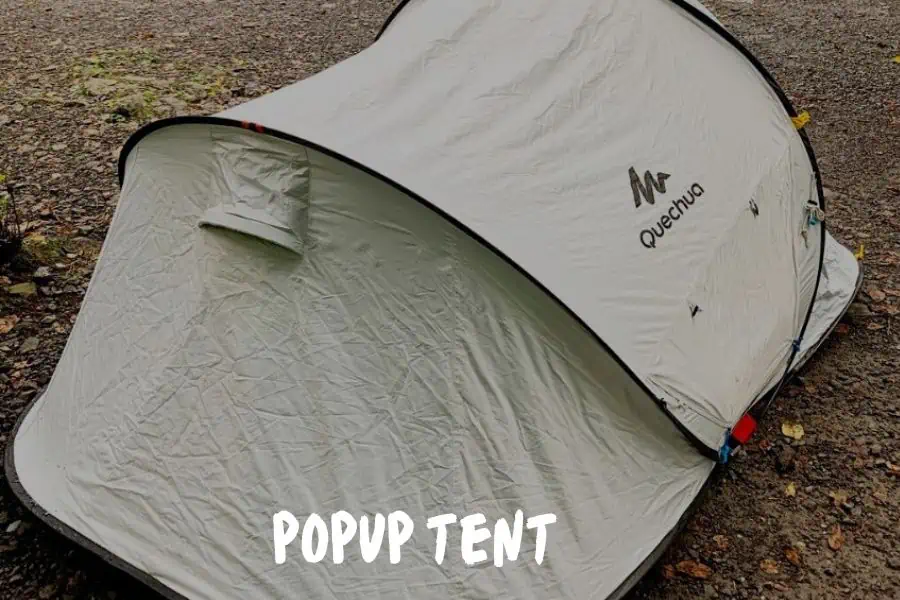
If even a few minutes is a few minutes too long, and you want a tent that can be set up in a matter of seconds, the pop-up tent is just what you need.
With pop-up tents, it’s just a matter of taking it out of the bag and throwing it into a wide, open space. By the time your tent hits the ground, it’ll be up and ready to go.
While there are a lot of cheaply made, useless pop-up tents out there, there are also some that are made very well, and perform outstandingly.
These tents are perfect for campers who like to change their camping spot frequently, because they allow you to set up and take down your entire campsite far quicker than any other type of tent.
I must mention though – figuring out how to fold these babies back up can take some practice. I personally wanted to pull my hair out on a number of occasions the first couple of times I tried packing up a pop-up tent.
Eventually, though, once you get the knack of it, it can be done quickly and easily. Promise.
Watching videos on YouTube that show someone folding up your pop-up tent can really help speed the learning process up, too (and you can skip the hair-pulling).
Our recommendation: Quechua Waterproof Pop Up Camping Tent.
Inflatable Tents
When it comes to tents where quick and easy setup is the selling point, inflatable tents are the new kids on the block.
Instead of having poles that are made out of aluminum, or steel, or fiberglass, or plastic like every other type of tent, these tents have inflatable air beams that act as the tent poles and keep the structure standing.
I haven’t had any personal experience with one of these yet, so I can only tell you what I’ve read about them.
Here’s the scoop:
First off, they come in several different shapes, including geodesic, cabin and tunnel.
They’re also fairly pricey, which is to be expected considering the fact that they’ve just appeared on the scene.
Now, here’s the interesting part. You’d think that not having poles would give you a lighter tent. However, that isn’t the case. Apparently, these tents tend to be heavier than other types of tents, so another miss for backpackers. Sorry guys.
Our recommendation: Moose Outdoors 4-Person Tent
Day Use Tents
Beach Tents
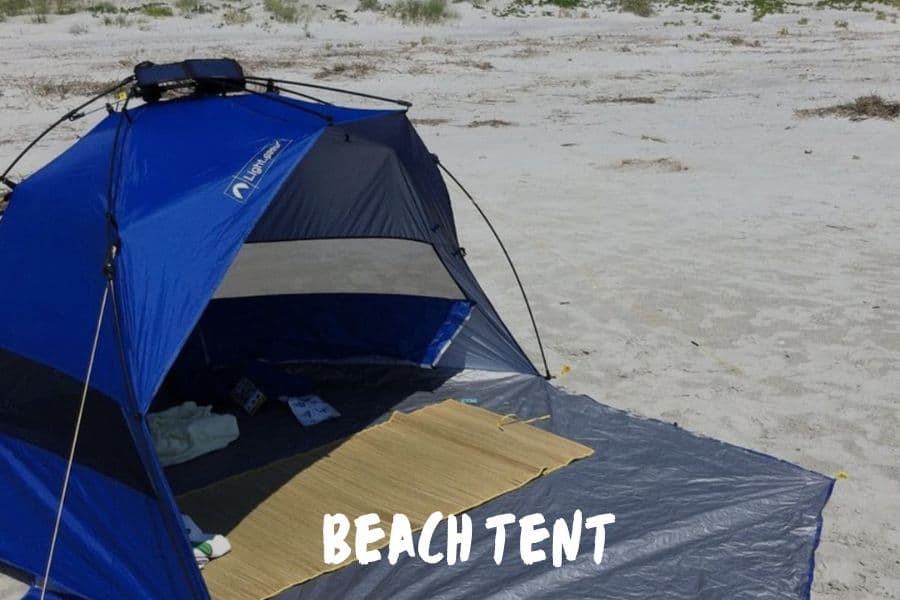
The sandy terrain of a beach is entirely different to the ground you’d typically set up camp on, so you’ll need a special type of tent if you’ve got your heart set of beach camping.
Beach tents provide fantastic ventilation to keep you cool, and UV protection to keep your skin safe from the sun’s rays.
They’ve also got sand bags along the bottom edges, so you can fill them up with sand to ensure they don’t fly away in a gust of wind.
It’s worth noting that certain types of tent stakes – namely the extra long ones – hold better in sand than others. If your beach tent doesn’t already come with extra long tent stakes, it’s definitely worth investing in a set to make sure your tent is extra secure.
Our recommendation: Easthills Outdoors Instant Shader.
Canopy Tents

While the rest of the tents we’ve gone over are designed to be slept in, the one exception on our list is the canopy tent.
Although it isn’t meant for sleeping, we can’t deny that the canopy too is indeed a type of tent.
They consist of 4 legs and a canopy top. That’s it – plain and simple. Although they don’t usually have walls, some models do come with removable walls as well.
These tents are primarily used for festivals, carnivals, sporting events and other places as a source of shade for people who are out in the sun all day.
Our recommendation: the ABCCANOPY Pop up Canopy Tent
I’ve Chosen The Style I Like… What Now?
Once you’ve found the type of tent you want, you might think it’s just a matter of finding one that you like the look of.
Not so fast.
There are a few other things you should definitely consider when picking out a tent, including:
- What material it’s made out of
- What kind of weather it’s suited to
- How much air flows through the tent
- How many people it can accommodate
- Extra accessories that it comes with
Here’s what to look out for…
Tent Materials
There are quite a few different materials used to make tents. But, most of the tents you’ll come across will be made out of one of the following fabrics:
- Nylon
- Polyester
- Canvas
- Polycotton
- Cuben Fiber
Nylon is the most common. It’s lightweight, stretchy and fairly breathable. But, it’s also less durable than polyester and not as resistant to UV rays.
Polyester is tougher and provides better UV protection, but it’s also heavier and less breathable.
Canvas reigns supreme when it comes to breathability, insulation and weather protection. That being said, it’s WAY heavier than it’s synthetic counterparts, and it’s got a heftier price tag.
Polycotton is an interesting option, because it gives you the best of both worlds.
Sort of.
See, it’s lighter than canvas, and even more durable. But, it’s still heavier than nylon or polyester.
Cuben Fiber is the least common material, and it’s a fairly new player in the game. It’s incredibly light, 100% waterproof, and it provides excellent UV protection.
However, it’s also really expensive and not very durable, so it won’t last you very long. For that reason, at this stage Cuben Fiber isn’t a viable option for most people.
Season Ratings
Next, you need to consider the season rating of a tent. The season rating indicates what kind of weather the tent is meant to be used in.
Can’t you just get a 4 season tent and use it all year round?
Well, no.
You see, 4 season tents aren’t actually meant to be used during all 4 seasons. Despite what the name suggests, they’re actually cold weather tents, meant to be used in late fall, winter and early spring.
3 season tents, on the other hand, are meant for warmer weather. These tents are perfect for camping trips in the summer, as well as late spring and early fall.
For more extreme weather conditions, you’ve got 1, 2 and 5 season tents.
Ventilation
I can’t stress enough how important it is that you find a tent that’s well ventilated.
No matter what kind of weather you’re camping in, ventilation is super important. If your tent doesn’t have enough air flowing through it, you’re going to get condensation forming on the walls, which will drip down onto you while you sleep. Not much fun.
To make sure your tent is well ventilated, look for large mesh windows, as well as roof vents and ground vents.
Adjustable vents are a bonus, because they let you control the amount of airflow you want depending on the weather outside.
Size
It goes without saying that you need a tent that everyone you’re taking camping can fit in. However, to make sure you all fit comfortably and have enough room to breathe, you always want to go at least a size up.
When tent manufacturers calculate how many people can fit in a tent, they don’t leave much wiggle room. So, unless you want to be packed in like sardines with nowhere to put your gear, make sure you get a tent that’s sized for more people than there will actually be in there.
The only type of tent this rule doesn’t apply to is the bivy tent. Even if you’re going hammock camping, you’re better off going for a double hammock than a single.
Accessories
Finally, pay attention to the small details, like extra accessories that can come in handy when it comes to staying organized.
These include:
- Storage pockets
- Gear lofts
- A rain fly
- A footprint
- A vestibule
- A screen room
- Awnings
- Room dividers
- Ventilation pockets
These features aren’t necessary, but some of them can be really nice to have, depending on the conditions you’ll be camping in.
For instance, if you’re camping in an area where there are lots of mosquitoes, a screen room will give you a nice outdoor area to relax in where the bloodsuckers can’t get to you.
To Wrap Things Up
Basically, there’s a type of tent out there for everyone.
No matter what kind of camping trip you have in mind, one of these types of tents is sure to be your perfect match.
Hopefully, you’ve now got a better idea of which type of tent is going to work best for you.
Now it’s just a matter of finding one that fits your criteria.
Remember to always read product reviews like the ones on our website before buying a new tent. That way, you’ll know you’re getting a product that users have been satisfied with.
Good luck in your search for the perfect tent!


